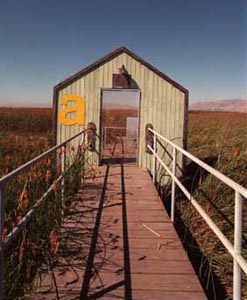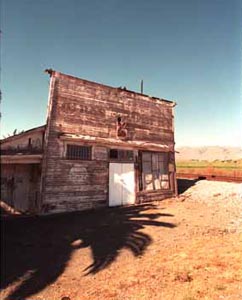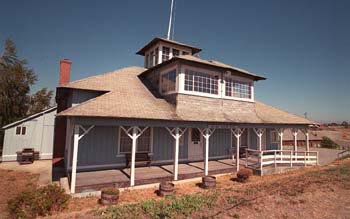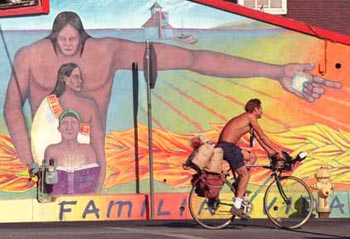Watchin' the Tidelands Roll Away
How can a small town with such a rowdy past roll over quietly for development? Easy. There's money, politics and a whole lotta high-tech shakin' going on.
Story by J. Douglas Allen-Taylor
ALVISO'S Star of the Sea Catholic Church sits atop one of Santa Clara County's great social faultlines. The church sanctuary faces Michigan Avenue, which could easily pass for a slumbering small-town street south of the Mexican border instead of a neighborhood in Northern California's largest city. Few things stir in the mid-afternoon heat. A single car passes. A couple of teenage girls walk by on their way to the grocery store. From one corner comes the sound of young boys playing a mid-street soccer game; from the other floats the sweet brass of mariachi. The houses along Michigan sit in proud individuality--each one different from its neighbor in form and color--a tribute to 40 years of planting and painting and spontaneous addition. The houses mostly turn inward, to cultured gardens and raked yards, where old men sit and laugh and drink beer and trade stories. Colored balloons, paper-covered tables and little girls in white fiesta dresses mark a backyard birthday celebration.
Nearly three-quarters of the 2,000 residents of this area, known as the New Chicago subdivision, are Latino, and half conduct most of their conversations in Spanish. The church's façade looks out on an old world that many thought had long passed away from Silicon Valley. It has not. Not yet.
Deacon Jaime Nuñez stands on the back second-floor porch of the Star of the Sea sanctuary, facing in the opposite direction, where Grand Street meets a vast, empty field of clotted dry dirt and brown grass, home to ground squirrels and birds, stretching virtually unbroken for three-quarters of a mile all the way to the distant line of moving cars that is Highway 237. He points across the open field and says, "It's coming. Oh, yes, it's coming. Right down that road."
He is pointing down North First Street, across 237. There, not yet visible from the neighborhood of Alviso, the great squatting behemoths of Silicon Valley are rising on concrete and steel-girded foundations. These high-tech campuses, as they are called, have turned their attention to Alviso's open spaces and, like enormous glaciers, are slowly but inexorably moving toward the 237 divide. Large tracts of Alviso land have been bought, fields are being cleared, pilings are being driven into the ground, and the city of San Jose is revamping its zoning code to make way for the great push. After many years of neglect, Alviso is finally getting some attention again. And the Alviso of today, ostensibly the valley's last small town, will almost certainly not survive.
ALVISO SITS AMID the salt marshes at the very end of North First Street at the convergence of Coyote Creek and the Guadalupe River, the only spot in San Jose that touches the shores of the San Francisco Bay. It spent its first 100 years as an independent city, but was consolidated into San Jose in a controversial election in 1968. The so-called historic district, the now nearly vacant original settlement of Alviso, sits at the extreme western edge of the community. Here stands the old port, the object of so many failed dreams to make the South Bay a major commercial center. It took a couple of hundred years for Santa Clara County to reach world-class status, and by then Alviso's port had become clogged with toxic silt and weeds and all but abandoned.
Stretching back from the port area to the northeast is the area named New Chicago. According to Alviso restaurant owner and community leader Ernie Escalante, development of New Chicago dates back to the mid-1950s, when the city of Alviso all but gave away lots in the subdivision in order to increase its population. Many of these lots were bought by Mexican-American migrant workers who had lived in local camps and worked the Santa Clara Valley's fields. These new residents had little interest in Alviso's port, which had long charmed so many would-be entrepreneurs. Instead, they concentrated on building a safe, comfortable community where they could raise their children and enjoy their time off. By all measures they succeeded.
Past New Chicago, east toward the Fremont hills and then north to the bay, are acres of environmentally fragile wetlands, some of the last left along the bay. At the edge of these wetlands the federal government has erected the San Francisco Bay Wildlife Refuge, a monument to the public's attempts to preserve this last spit of marsh, which once dominated the southern bay's edge. Within sight of the refuge, as if to mock its purpose, stand two solid-waste dumps: the Zanker Road dump and the old Owens-Corning dump, now sold to Zanker--both owned by Rich Cristina, one of Santa Clara County's top 10 contributors to local politics. Beyond the dumps lies the San Jose/Santa Clara Water Pollution Control Facility, the urinary tract of the valley, which daily spews millions of gallons of fresh water into a saltwater world.
Mary Cuevas stands in the playground of George Mayne Elementary, Alviso's only public school and the northeastern border of New Chicago, shepherding a crowd of busy day-care children through playtime. The school grounds afford some of the most spectacular unbroken views from the floor of the Santa Clara Valley: east to the hills above Milpitas and Fremont; west across First Street, the Guadalupe River and the bay, and on up to the mountains marking the edge of the Pacific Coast. It is a view that development will almost certainly block out. In its place, next door to the children of George Mayne Elementary, a collection of high-tech campuses is slated to rise.
Cuevas looks around the valley from under the shade of a pink Zorro-style sun hat. "How can we live with these things coming here?" she asks. "We want the community to stay the way it is. It is special. I can walk everywhere in the neighborhood, and don't have any problems. We don't even have to lock our doors. Everybody knows each other here." A homeowner and 28-year resident of Alviso and a teacher at George Mayne, Cuevas believes that industrial development and the present Alviso neighborhood cannot co-exist. "Development will be the end of Alviso. People will not be able to stay here. I've got some property in the high desert. That's where I'm going," she says, "when we have to leave Alviso."
Cuevas clearly believes what she has heard is proposed in the Alviso master plan, wherein the high-tech invasion of Alviso is spelled out in a crisp, 70-page, copier-produced document published by San Jose's Department of Planning, Building and Code Enforcement. The plan was patched together over the past six years by the Alviso Task Force, a City Council-selected body of residents, business owners and planners that over time became increasingly pro-development. A proposed blueprint for zoning intended to become part of San Jose's general plan, the Alviso plan would eliminate most of Alviso's open spaces and surround the residential neighborhood with a combination of industrial and commercial development. After approval by the task force, the Alviso plan is scheduled to go to the San Jose Planning Commission for a public hearing, and after that to the council for final approval. An environmental impact report was just completed and released to the public last week.
But a good number of the players in this drama--politicians, planners, local landholders and some of the heaviest-hitting land developers in the area--are acting as if the proposed plan is already a reality.And residents like Cuevas believe that fighting the combined powers of money, real estate and political influence is about as useless as trying to maneuver a boat through Alviso Slough at low tide.
Boss-Laid Plans
CITY COUNCILMEMBER AND Vice Mayor Margie Fernandes, who represents Alviso and who has been the driving political force behind the master plan, reveals matter-of-factly that the implementation of the plan in its present general outlines is pretty much a done deal. "Anyone with plans to develop in the area has either seen the master plan or should be aware of it, and should be in compliance," she says. "We are already acting on the plan."
Task force member Lonnie Gross agrees. "We don't need the frigging master plan," she says bluntly. "We've got the things in place. The land has been sold. What do we need the plan for?"
What for, indeed? Cisco Systems recently purchased 150 acres of Alviso land for possible expansion of its campuses. Lincoln Properties West, the Foster City-based subsidiary of a national multibillion-dollar development company, has bought up approximately 27 acres of property along the Guadalupe River near Lafayette. Without a single building on it yet, the property is assessed at close to $17 million. And it won't remain without buildings long. Lincoln has already graded some of the land near Highway 237, sunk metal pilings and begun advertising for leased space in a 305,000-square-foot, two-story R&D office park. A Lincoln spokesperson says the company "does not make comment to the press about our development plans."
Equally tight-lipped is Peery-Arrillaga of Santa Clara. According to Forbes magazine, the investment and development company bought up cheap land along First Street before the high-tech boom, built commercial space for the high-technology industry, and then sold much of their holdings for a killing in the 1980s when high tech moved north. The transaction helped put Richard Peery and John Arrillaga on the Forbes list of the 400 wealthiest Americans, pushing their joint worth past the $1 billion mark. Today, Peery-Arrillaga holds some 50 acres of land, worth $19.5 million, smack in the middle of the field up for campus-style development under the Alviso master plan.
On the task force itself, two of the main individuals leading the charge for intensive industrial/commercial development of Alviso are also two people who stand to gain economically from such development.
Task force member Lonnie Gross and her husband, Santa Clara Water District chairman Bob Gross, both Berryessa residents, own three buildings in the downtown historic district, valued at approximately $130,000 total. They have restored one of the buildings, the old Union Warehouse Cannery, for their own office as well as a reception facility. With the development of the Lincoln Properties land down the street and the increased foot and vehicle traffic in the area with the coming of the campuses, the value of the Gross holdings almost certainly will increase.
Lonnie Gross complains that the city of San Jose has been ignoring Alvisans' complaints for years, including problems with a poor storm drainage system, lack of police protection, lax city code enforcement and a San Jose airport policy that allows planes a leisurely--and distinctly loud--curving pass through the airspace above Alviso. Dead dogs, she says, remain on the streets for days. Abandoned vehicles stay for months. Her husband once lost a suit against San Jose that faulted the city for failing to provide adequate drainage and street repair. "The city looks down on Alviso," Lonnie Gross says. "They always have. They wouldn't treat us like this if we were in Willow Glen or Berryessa." Gross believes that will change with high-tech development. "Cisco will be our savior," she says. "They have a middle-class audience. The first time they can't have a meeting because the planes are too loud--well, they'll take care of it."
Listening to Gross and others, it's clear Alvisans don't believe San Jose will give them their share of services unless there are more powerful forces demanding it. One has to wonder: Is it fair that Alviso has to sell its soul for a fair share of city services? To get dead dogs scraped off its streets and storm drains cleared? Isn't it enough that Alviso has been the backwater of Silicon Valley--with the dump, the sewage-treatment plant and about 150 years of mining tailings under its belt?
Mayberry R.I.P
DICK SANTOS WOULD say fair isn't the point. "We've had a hate relationship with San Jose for 30 years," he says. "All of our dreams have been tarnished for 30 years. We were walking in mud and dirt and shit, and every day I get up I'm bitter about what San Jose did to us."
Santos, a 30-year veteran of the San Jose Fire Department, is the most feisty and pugnacious member of the task force. He is also an ardent development supporter. Santos' father, Tony P. Santos, was a political player in Alviso when it was still a separate city.
In Alviso, people ignore the opinions of the Santos family at their peril. Many stories about the family either start or end with a fight. Bob Gross remembers Tony P. Santos once punching out a man at a flood-control meeting. ("The man went sprawling, the folding chairs went flying, and the flood-control experts went running out the door," Gross says, with a big smile.) One task force meeting broke up over the issue of naming a street after Tony P. Santos; Dick Santos threatened to fight a man who called Santos' father "a crook."
The family migrated to Alviso from Portugal by way of Hawaii more than 80 years ago, gradually moving from migrant workers to cannery workers to landowners. Today, the Santos family owns some 16 pieces of residential rental property in the New Chicago subdivision and a trailer park (valued at more than $1 million) across the Guadalupe.
In a task-force debate over commercial/industrial development versus additional housing, Santos chose commercial/industrial. "Why should we have more housing?" he asks in rapid staccato, dark eyes flashing anger. "The city doesn't service what we have right now. We don't want a lot of outsiders moving into Alviso. We like it just the way it is now. They said they wanted to put in low-income homes, but we've already got plenty of those. They should dump that shit in Berryessa. Let them build their campuses here. The people can come in and work, eat at our restaurants and get their asses out of town at night. That's the way we want it." He denies that his family's economic interests color his views on the master plan, saying that his only goal is to maintain the character of the community he has lived in all of his life.
But even though he "hopes and prays" that Alvisans can keep their community intact, he concedes that the coming development is going to change things. "We can't keep our little Mayberry," he says. "We're never going to be the same."
Environmental Disaster
IF THERE ARE ANY doubts that Alviso will never be the same, the just-released draft environmental impact report provides stark proof. The EIR predicts that the implementation of the master plan will result in "significant, unavoidable environmental impacts," including impact on storm water drainage, disruption of "sensitive Baylands habitats," displacement of protected species, loss of wetlands, contaminated runoff resulting in the degradation of the river system; potential hazardous-materials spills from future industrial use on contaminated sites "within 1,000 feet of residential uses and 300 feet of the refuge" in areas that are seismically unsound, and the possible release of toxic air contaminants that pose health risks to the residential area and the elementary school. The EIR says that the master plan "will result in future development being built on sites which contain expansive soils, unengineered fill materials, and/or bay mud, which would pose a substantial hazard to property and/or human life."
Never mind that development has already begun.
But even the EIR itself seems to have no doubt about the inevitability of the passage of the master plan in its present form. It states that the master plan "was designated as a preferred alternative" by the task force. At the time of the release of the EIR, however, the task force had discussed the plan in depth but had not yet taken a vote on its adoption.
Port of Calumny
ANYBODY WHO IS asked to defend the shotgun marriage between Alviso and high tech will point to the task force, created to represent the interests within the community during discussion of its master plan. But the fact is that the task force of today looks nothing like the body as it was originally conceived.
Today's meetings are quiet and sparse. Neither a microphone nor translation service for the audience is provided, since nowadays the audience is nonexistent. But the early debate has been described as fierce and heated, with many community members in attendance. Opposition to Alviso's industrial development was initially led by longtime Alviso environmental and community leader Savas Alvarez.
Alvarez, a 48-year-old carpenter, charges that the unspoken, underlying goal of the Alviso plan is to facilitate development by moving the Mexican-American community out and moving other people in. "It could be white people, Orientals, Mexican nationals, Ethiopians," he says. "Doesn't matter, as long as they have money. This is going to be just another yuppie community." He says the squeeze-out has already begun. "They won't let us build any new homes. Many lots are vacant. And the city won't let us improve our property to come up to code standards; they keep putting on restrictions. You watch. Pretty soon, after they build things up, they're going to come around and say we're out of compliance, and we've got to go."
Alvarez led an spirited battle within the task force to have more residential zoning included in the master plan. He lost, and has since lost interest in the task force as well. "I was pressured off," he says. "A lot of the businessmen would come to the meetings and shout from the audience, 'Why is Alvarez up there? He's anti-business.' "
Alvarez was not the only Alvisan who lost interest in the task force over the years. Out of 21 members originally appointed to the task force, only five attended the last meeting. There is consensus that the residential area will not grow and open space will be filled.
Bob Gross explains the waning of interest this way: "The indigenous people went into the task force with resentment and jaundice in their eye," he says. "They didn't have the discipline to do the master plan. People were turned off by the long discussions about infrastructure, the social implications of development and the preservation of the historic district."
ALTHOUGH OPINION in Alviso is deeply divided over the issue of industrial development, the one thing almost all Alvisans have in common is a deep suspicion of the intentions of the city of San Jose toward the north-end community. In fact, Alviso's stormy relationship with the city of San Jose is well documented.
San Jose reaped rich benefits from the 1968 consolidation, using Alviso real estate to expand its sewage treatment plant. According to a 1993 Mercury News article, the size of the plant went from 392 acres at the time of the consolidation to 1,764 acres in 1993. The same Mercury News article also says that "it's worth noting [that then-Mayor Tom McEnery] often speaks of how limits on the sewage outfall could devastate Silicon Valley's future." ("There would be no Silicon Valley if San Jose hadn't taken over Alviso," says Bob Gross. "The city needed the buffer zones to expand the water treatment plant. Places like Cupertino and Milpitas could never have expanded without it. In fact, the whole idea of San Jose consolidating with Alviso was primarily to get access to the water treatment area.") San Jose also used Alviso to corner the Santa Clara County market on garbage dumps. In return, the city promised that Alviso would get the same treatment as the rest of San Jose. Instead, services were long delayed or never delivered at all. Many streets went unpaved and gutters unbuilt. Police protection was spotty, at its best. ("At the task force meetings, the city representatives are always talking about the fact that there's no crime problem in Alviso," says Lonnie Gross. "That's because people in Alviso know it's no use calling the police for minor crimes. They don't come at all. Or they come too late to do anything. So people don't even bother to call the police. They just take care of these things themselves.")
In the early '70s, Alvisan protesters blocked the Gold Street bridge over the Guadalupe, charging motorists a toll in order to pay for street repairs that San Jose had failed to provide. In response, then-San Jose City Manager Ted Tedesco suggested in a report that Alviso's population should be cleared out, and the land should be converted to "industrial, agricultural and public uses ... includ[ing] ... landfill and expansion of the sewage treatment facilities." The high point--or low point--of the Alviso-San Jose marriage came in 1982 and 1983, when Coyote Creek twice overflowed and flooded Alviso. Many Alvisans charged that the city's neglect of the creek's levee system led to the flooding, and some, like Ernie Escalante, believe residents were purposely kept away from their homes after the flood in the hope that they would abandon them permanently.
Bob Gross says that prior to 1992, Alvisans almost never saw their councilmember, and the needs of the community were pretty much ignored by the city. "The first priority of San Jose was greed," he says.
But San Jose Symphony President Shirley Lewis, who represented Alviso and Berryessa on the San Jose City Council from 1980 to 1992, disputes Gross' contention. "During the time I was on the council, a lot of the groundwork was laid for the present development of Alviso," Lewis says. "I spent more time per square foot in Alviso than I did in all of Berryessa." Lewis says that she has reviewed the original consolidation document with an attorney, and she does not agree with the contention that San Jose reneged on the agreement. "Everything that was promised was provided, plus," she contends. "In many ways, based upon its population, Alviso has a higher level of services than other sections of San Jose." She cited the presence of the Alviso Fire Station as one example.
Lewis' tenure on the council was marked by two major Alviso controversies: the floods and the dumps.
Lewis was in office during the 1982 and 1983 flooding of Coyote Creek, and she admits that the city did not have adequate flood-control plans in place during that time. "We could have done some things that were destructive to the community, but I was seeking a long-term solution that was not negative in nature," she says. "I spent 10 difficult years working on the Guadalupe and Coyote flood-control projects. We put in storm drains and gutters and paved streets that were not there before." According to Bob Gross, the river flooding problem, at least, has been solved, and the Guadalupe and Coyote no longer pose threats to Alviso.
But the Alviso dumps remain controversial. In 1987, the Mercury News reported complaints raised by local businesses over a 46 percent tax break given to the Zanker Road landfill by the City Council. And in 1990, the Mercury News reported a second controversy when City Council made a change in the general plan to allow the old Owens Corning dump to be converted to a landfill shortly before the Zanker Road landfill entered into negotiations to purchase the property. Favoritism was charged in both instances because Rich Cristina, the owner of the Zanker Road landfill, is Shirley Lewis' cousin and Lewis voted for both items.
Today, Lewis still denies the charge. "Was it fair that Alviso had two solid waste facilities?" she asks. "I don't think it was good planning in the past. But the solid waste facilities were in existence when I got there." Lewis says that she could not recall the details of the tax break. Owens Corning was merely the case of the city trying to clean up an unsafe site. "It was full of contaminants. We got it designated as a landfill so that the owners could get it cleaned up." Lewis says that Cristina "should not be punished simply because he is the relative of a city official."
Bob Gross and Dick Santos feel that San Jose's relationship with Alviso took a dramatic turn with the 1992 election of Margie Fernandes to the San Jose City Council to replace Shirley Lewis. Both landowners believe that Fernandes paid attention to Alviso. Under her direction the task force was formed and the master plan started, and Fernandes began to convene regular community meetings to discuss problems and issues. Among other things, Fernandes helped secure $200,000 in city appropriations toward the construction of a library and community center in Alviso. Lewis praises Fernandes for doing "an excellent job."
Santos says that he and Fernandes have become "kind of allies" after an initial rocky start. "Do I trust her? No. But she's been the best councilmember we've had. She participates all the time. Is she working fast enough? No. But she's the most honorable councilmember. I think she respects Alviso."
"Alviso is a wonderful little place," Fernandes says in a telephone interview. "We're trying to meet their needs and bring them up to par with the rest of the city. We want to do it while still preserving the small-town atmosphere there. I think it is possible for Alviso to remain the same."
The councilwoman says that even though there has been some difficulty in sustaining community interest in the planning process, the development plan is entirely the product of the citizens and property owners of Alviso. "It was the task force that developed the master plan. I just facilitate."
But when asked if the community ever had the option to leave open space undeveloped, Fernandes says no. "You can't say to landowners that they can never develop," she says. "It's against the Constitution to tell people, 'Your land is going to have to be a park.' "
Fernandes is wrong on that second point, of course. Government tells landowners what to do with their land all the time; it is the very nature of the zoning process. It is the way much of the valley's open space has been preserved: many of its wildlife refuges, protected wetlands and parks. But perhaps Fernandes simply couldn't imagine the city mounting a campaign to say no to these particular landowners at this particular time in the evolution of Silicon Valley. If so, she may not be wrong after all.
To learn more, visit the Alviso Community Web Site at www.alviso.com.
Owl Be Damned
CRAIG BREON, environmental advocate for the Audubon Society of Santa Clara Valley, is not pleased with much of the Alviso master plan at all. He calls it an environmental disaster, disrupting both the existing residential community and the wetlands area, and in keeping with destruction of the Alviso environment that goes back to the Gold Rush days. Breon notes that Alviso has been the home of six separate garbage landfills that have leached waste into the bay waters. Nineteenth-century quicksilver mining at the headwaters of the Guadalupe eventually deposited toxic mercury in the mud at the bottom of the sloughs surrounding Alviso, poisoning the waters and killing off a thriving oyster-harvest area. Because of contamination by asbestos fibers from one of the flood control levees and from materials dumped by manufacturers into a local landfill, Alviso was placed on the Environmental Protection Agency's Superfund in 1986, the list of areas most in need of toxic cleanup. Further, Breon says, "the freshwater flow from the San Jose wastewater treatment facility in Alviso is so constant, powerful and voluminous that it is turning the saltwater marshes into freshwater marshes," with many resulting changes in the ecosystem. The marsh conversion threatens the habitat of two endangered species, the salt marsh harvest mouse and the California clapper rail.
Ironically, the mercury deposits and the freshwater flow are also what killed off Alviso's richest economic asset: the port area. The combination of toxic wastes and thick reeds generated by the fresh water eventually choked off the channels leading to the Alviso port, and made it economically and environmentally unfeasible to continue to dredge them.
Breon, who has worked on several past projects in the Alviso area, says the Alviso master plan allows development to butt right up against existing bird nesting areas along the wetlands, even though biologists have reported that the birds require a 50- to 300-foot buffer zone in order to nest. He says Alviso is also part of the habitat of the burrowing owl, which will probably be put on the endangered species list soon, but he warns that quick development would destroy their habitat before legal protections can be put in place. And none of those habitats, valleywide, are guaranteed. Alviso property owners Peery-Arrillaga were recently caught plowing under burrowing-owl nests in a parcel of land the firm owns in Mountain View.
Breon says he plans to begin mounting opposition to portions of the master plan now that the EIR is issued, and making his case during the public hearings before the council and planning commission. And he says that there are possible solutions to Alviso's environmental problems that would also support development. "The wastewater treatment plant pretty much has to be where it is, next to the water," he says. "But the dumps can move away from the wetlands." He cited as an example the Kirby Canyon dump in the Diablo Range, which is removed both from wetlands and population centers. And he says that San Jose should be looking first at restoration of the wetlands areas, which the city's general plan lists as "the most important natural resource in the area," and then fit any development around the restoration plans.
"But right now, San Jose has virtually no wetlands-protection policy," Breon says. "It's pretty bleak."
Sittin' on the Dock of the Bay
IN CONTRAST TO its present sleepy-town demeanor, Alviso is famous for its wild and offbeat side. In its earliest days, when it was still a major port, it boasted a miniature version of San Francisco's Barbary Coast. Bordellos endured into the '40s, gambling houses into the '80s. Before the demise of the port, drug dealing and shootings were common. Debates in the old Alviso City Council were sometimes settled with fistfights. In the '70s the counterculture invaded, and the muddy channels at the base of the town became a moveable feast of illegally squatting houseboats. All of it is gone now, a faded but still colorful ghost that haunts the vacant docks.
Though he has clearly calmed down a bit himself, longtime resident Bill Cole comes out of that different-drummer Alviso tradition. White-haired and "basically retired," Cole has a degree in English literature, a lifetime experience in everything from sailing to manufacturing elevators to working as a juvenile probation officer, and fond memories of Alviso's wilder days.
Smiling and sitting on top of a picnic table at the Alviso marina, speaking slow and mellow between draws on a thin cigar, Cole talks for sunlit hours about the things he has seen here at the butt end of the bay. Slough Dougie, a hippie who used to camp out in a lean-to amid the marsh, and who could tell you more than any scientist about the flora and fauna of the wetlands. The shipboard socializing that would start in the morning and go from ship to ship, and beer to beer, until the evening, when the barbecues would start. The gambling casino run by the Santos family, catering to African-Americans coming down from Oakland. The drug raids. The floods. The bitter battles over consolidation. The old man O'Neill, who collected piles of junk in his yard on the off-chance that another world war would break out and he'd make a killing on scarce items, and who ran a migrant camp so packed and squalid that its houses were literally falling apart at the end.
Cole slowly contemplates whether or not he ought to write down a history of Alviso ("Why not? I did major in lit.") Meanwhile, he is one of several residents who carries around the living history of the community in his head. He fits in well in today's Alviso, an integral part of the wind-salted scenery. But in a gentrified Alviso? A little scruffy around the edges, Bill Cole would probably be arrested for suspicion of vagrancy. Or lack of conformity.
Not far to the northwest of where Cole sits on the marina, a collection of barn swallows hovers above the dirt dike that leads into the bay. It is the nesting season, and they are protecting their newly hatched chicks. Hikers along the dikes this time of year get a rude and frightening surprise. When angry screeched warnings and increasingly lower circling does not drive intruders away, the swallows will attack. A collision with a full-grown person can break a swallow's neck, but that does not seem to matter. The swallows defend their homes at all cost.
Their fragility, and the importance of preserving their neighborhoods, is part of the reason why there is a national wildlife preserve along the Alviso shore to help protect them and create a buffer zone so that no development can intrude. But there is no plan to protect the human inhabitants.
Among its objectives, the Alviso master plan lists that it seeks to "retain the small-town character, strong community identity and neighborliness" as well as "preserve and protect Alviso's strong natural amenities, including the Guadalupe River, Coyote Creek and baylands." Although he thinks the plan as presently written will not accomplish those goals, environmentalist Craig Breon thinks they both can be preserved, if San Jose has the will to do so. "The Alviso residential area is important, just like the rest of the Alviso environment," he says. "It can use some renovation and economic revitalization, but it ought to be saved. It's not the usual strip-mall, tract-housing type of development you usually see around here. It's unique."
[ San Jose | Metroactive Central | Archives ]
Copyright © Metro Publishing Inc. Maintained by Boulevards New Media.
![]()
 Bridge to the Past: Once a scrappy, bustling frontier port, then a rustic residential community, Alviso soon will likely resemble other high-tech parks that surround the San Francisco Bay.
Bridge to the Past: Once a scrappy, bustling frontier port, then a rustic residential community, Alviso soon will likely resemble other high-tech parks that surround the San Francisco Bay.
Photographs by Christopher Gardner Muddy Waters
Muddy Waters
 Slim Swimmings: Four feet is the deepest swimmers can go at the city-built pool in Alviso; community leader Ernie Escalante calls it a "kiddie pool" and says Alviso deserves a larger facility.
Slim Swimmings: Four feet is the deepest swimmers can go at the city-built pool in Alviso; community leader Ernie Escalante calls it a "kiddie pool" and says Alviso deserves a larger facility.

Pucked Up Situation: Players from the Mexican American Community Services Agency street hockey team practice in the playground behind Star of the Sea Catholic Church in Alviso. Their community could be shattered by the coming development. Dumping on Alviso
Dumping on Alviso



The Road to Yuppieville: A mural at Ernie Escalante's Restaurant on North First and Liberty echoes Alviso's divided attitudes toward development--should it go away, should it stay, or does it need more study?
From the August 20-26, 1998 issue of Metro.
![[Metroactive Features]](http://metroactive.com/features/gifs/feat468.gif)